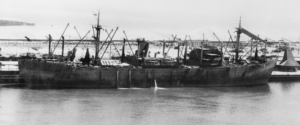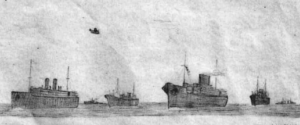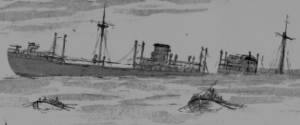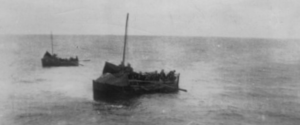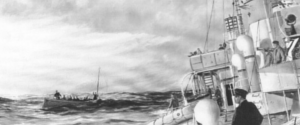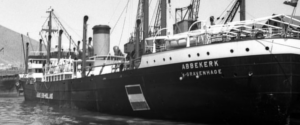
WWII VETERAN, MEMBER OF IDAHO’S 148TH FIELD ARTILLERY
“During WWII, I kept a small notebook. When I retired in 1980 and returned to Boise, the first thing I did was to buy a computer. Earlier, I had dusted off the notebook, and started reading. After so long a time, it didn’t make much sense, and the spelling was atrocious. I decided to type it out. I sat down at the keyboard, and started typing. As I did so, memories returned.â€
To read Willard A. “Bill†Heaths whole article click here.
Here is the part about the Tjilitjap evacuation:
At 0430, Feb. 26, the remaining staff of HQ FEAF formed a motor convoy consisting of 17 cars, one bus, and two trucks, struck out for the southern port of Tjilatjap (pronounced chill-a-chap), 160 miles away. We would pass through such exotic-sounding places as Oedjoengbroeng, Tjitjalengka, Tasikmalaja, Bandja, Madjenang, and Wangon. All smelled of dead fish! A volunteer member of the N.E.I. armed forces, a sergeant, was our guide and interpreter. We arrived at Tjilatjap at about 1600. There, we joined a growing group of Americans from units on the island, all hoping to escape the advancing Japanese. We bid a grateful goodbye to our Dutch guide, who declined to leave with us, saying Java was his home, and it was his duty to defend it.
That evening, we boarded a decrepit-looking – but very serviceable – Dutch freighter, named the ABBEKERK. Its few cabins went to badly injured Navy personnel, some officers, and a few civilians. There were no other living quarters or facilities for human beings. We were human cargo. But this was our only hope for freedom, so we were very glad to be there. Ultimately 1500 men would crowd the decks and holds.
In preparation, we organized committees. The mess committee consisted of senior mess sergeants. Food supplies went to the forward deck where the sergeants and their KP helpers set up field kitchens. Cartons of corned beef were stacked here, the beans over there, and so on, far into the night. Another committee was busy filling every container it could beg, borrow or steal, with drinking water. Another committee was busy building latrines and showers.
A sloping wood platform extended over the side. A 2×4 frame went over that, with more 2x4s serving as toilet seats. A similar structure was constructed for showers. Running water? It was pumped from the sea and dispersed through hoses running across the platform. It wasn’t pretty, but it worked for what turned out to be an eight-day journey to Australia.
Feb. 27, 1942 – we were supposed to depart last night, but hadn’t finished loading supplies and equipment, including a number of machine guns. An Air Corps group had salvaged the guns and brought them along. Conditions bad; morale extremely good all things considered. We left the dock about 1700, and steamed slowly out of the river. Several other ships followed.
The plan was that we were to rendezvous with other ships and form a convoy. We didn’t know it at the time, but this was the date of the Battle of the Java Sea north of Java. It was a battle that all but wiped out what remained of the U.S. Asiatic Fleet, and the allied fleets. Fortunately, our skipper, Captain Wijker, had other ideas. Soon we were in the Indian Ocean, headed for Australia, alone and at full speed. We would learn later that of the 24 ships leaving Tjilatjap that evening, 13 escaped, and 11 were sunk or captured by the enemy.
The following day about 1000, the lookout spotted a plane – two engines, probably a medium bomber. It disappeared on a straight line into a cloud bank. Another smaller plane was spotted at 1530, and it had seen us! It circled and followed us for approximately 45 minutes. The ABBEKERK’s only armament was a four-inch gun on her stern. It could be used against aircraft, but not effectively. However, yet another committee had mounted the 30 and 50-caliber machine guns on the ship’s railings, and they were manned and ready.
When the attacking aircraft came within range, first the four-incher fired. As the plane came closer, the 50s opened up. Then the 30s cut loose. A hail of tracer bullets reached out to our tormentor. At the same time, the ABBEKERK still at full speed made every possible evasive move. We finally got a good look at the plane as it veered off.
It was a Mitsubishi Zero, either out of ammunition or intentionally light-loaded for reconnaissance duty. A couple of the guys swore they saw two small bombs drop in to the ocean. My guess is that the pilot realized he’d run into a hornet’s nest, and decided to get the hell out of there. What the guys thought were bombs were probably extra wing tanks for long-range surveillance.On March 4, at 0750, the good ship ABBEKERK arrived at Fremantle on the coast of Western Australia. The injured Navy personnel were helped onto trucks and taken to a hospital in Perth. Morale was still high, and the officers toted their own luggage. The train left Fremantle 2120 and arrived at Northam 0135 the next morning. After a good night’s sleep and a good meal, everybody was in much better humor.

